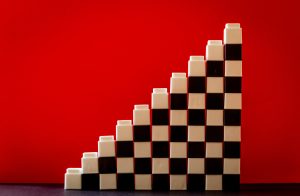
July 1, 2021, by Rupert Knight
Spatial thinking: the missing piece in mathematics education?
In this blog post Catherine Gripton explores the potential of spatial thinking for supporting children’s success in mathematics, starting from the early years of primary school.
Spatial thinking improves mathematics learning
International rankings for education, such as TIMMS and PISA, compare countries by the performance of children and young people on mathematics tests. These are frequently used to judge success of education systems and generate headlines such as ‘Pupils in England improving in maths but falling behind in science’. They lead us to ask what makes the difference between countries and how we can improve our performance. Sorby and Panther’s (2020) research article suggests that improving children’s spatial skills may be a way to do this. They found that higher mathematics scores in PISA for 15 year olds are significantly correlated with better spatial cognition. This supports a wealth of research, which shows that spatial thinking predicts mathematics attainment and that spatial thinking can be taught (Resnick et al. 2020). Given this, researchers suggest that spatial thinking may be an under-utilised route to improving children’s mathematical learning (Verdine et al. 2017).

Spatial thinking (often referred to as ‘spatial reasoning’ in education) is crucial in geometry and measurement. It also supports number understanding, which makes sense given that many representations of number are spatial constructions (e.g. number line, hundred square, ten frame, Dienes blocks). It is crucial in visualising and mental manipulation in mathematics at school as well as being essential for everyday activities such as navigating around a building, packing a bag or choosing clothes.
What is spatial thinking?
There are many types of spatial thinking. These might involve looking at spatial features of objects or spatial relationships between objects. Spatial features might be static (still), such as shape properties, or dynamic (changing or moving) as with shape transformation. Spatial relationships can also be static, such as the relative position of landmarks to each other, or dynamic as with following a route and predicting how to intercept a ball. There are many spatial concepts, including:
Spatial concepts – Examples
object identification and location – recognition by shape; finding an object within a room,
landscape or image
spatial properties of shapes – size, dimensions, shape properties
capacity and volume – what it will hold or how much space it takes up
symmetry – in shapes/images or patterned arrangements
position – where it is in relation to other things
distance, length and area – how far away or between; surface or footprint size/shape
orientation – which way up or around
shape composition and decomposition – combining shapes; constructing; 3D nets
direction – which way to move or face
transformation – sliding, rotation and reflection
perspective-taking – visibility; viewing from different perspectives; taking different viewpoints
(e.g. of others)
scaling – enlarging/shrinking; scaled maps, plans and models
navigation – routes and wayfinding
Teaching spatial thinking
Teaching spatial thinking needs to start when children are very young, supported by movement and physical development. Spatial reasoning is now included in the early years curriculum in England (EYFS 2021). The Early Childhood Mathematics Group’s (ECMG) recently published spatial reasoning guidance, which offers information about what spatial reasoning is and how to teach it appropriately from babies up to 7 year olds. It summarises the key aspects of spatial thinking, explains these and provides a trajectory for spatial thinking development in stages.
Hearing and using spatial words in context supports children to form an understanding of spatial concepts which they can then use for spatial thinking. For example, using the term ‘between’ when asking a child to stand in a line between one child and another can help the child to form a conceptual understanding of ‘between’ and use this when thinking about their route from home to school (e.g. take the path between the post box and the shop) or when locating 5 on a number line (e.g. between 4 and 6). Gesture can further support concept formation by enabling communication, emphasising a spatial concept in an embodied way and by supporting the learning of spatial words. We might use simple pointing or movement gestures to supplement spatial language as well as tracing shape outlines with our fingers or hands to highlight spatial properties. Movement and exploration outdoor or in larger spaces can help develop spatial thinking, particularly where we draw children’s attention to landmarks, viewpoints and routes.

Extending our teaching of spatial thinking
In a packed mathematics curriculum, it can be difficult to find additional space for spatial thinking teaching so perhaps developing spatial thinking through existing mathematics practice might be the key. Visualisation is incredibly powerful for this. Using spatial representations including manipulatives in mathematics teaching and drawing to develop and communicate mathematical thinking. Outside of mathematics focussed sessions, there are lots of opportunities to develop spatial thinking across the school day through:
• using spatial vocabulary in context, accompanied by consistent gestures
• activities such as observational drawing
• encouraging visualisation
• organising information in tables, diagrams, pictures and models
• encouraging children to create mind maps, concept maps or story maps to map out their ideas spatially
• provision of blank paper, jotters or whiteboards for drawing and note-taking
• using manipulatives (physical and virtual)
• outdoor activities and off-site visits
• physical games that incorporate judging spaces, distances and trajectories
• games (such as barrier and board games) and resources (such as pattern blocks, jigsaws, marble runs and Lego®) during break times or in extra-curricular clubs
References
Sorby, S. A., & Panther, G. C. (2020). Is the key to better PISA math scores improving spatial skills? Mathematics Education Research Journal, 32, 213-233.
Verdine, B.N., Golinkoff, R.M., Hirsh‐Pasek, K. and Newcombe, N.S. (2017), VI. Discussion and implications: how early spatial skills predict later spatial and mathematical skills. Monographs of the Society for Research in Child Development, 82: 89-109. https://doi.org/10.1111/mono.12285
No comments yet, fill out a comment to be the first

Leave a Reply